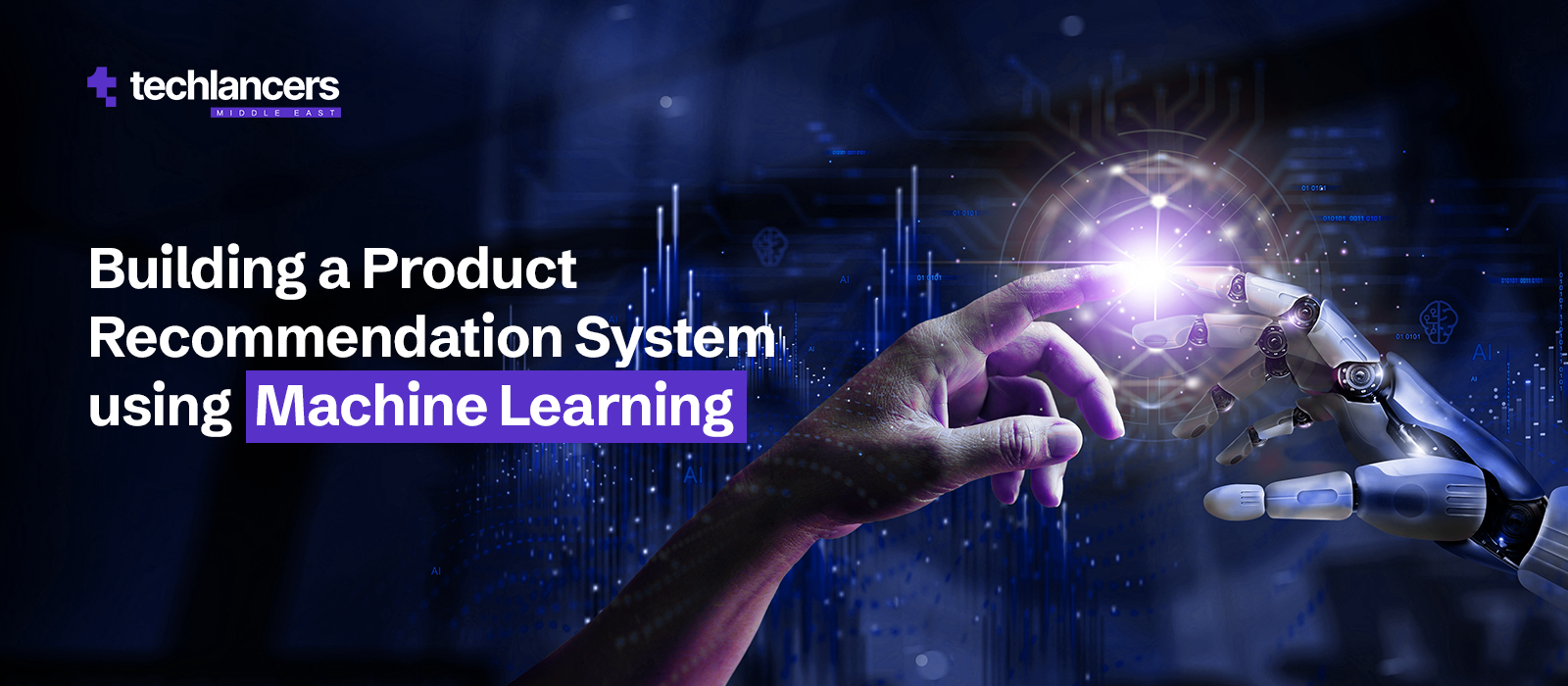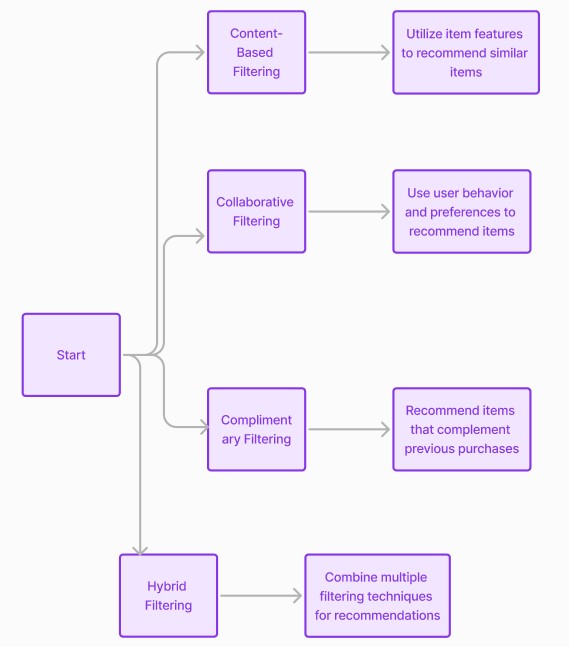Building a Product Recommendation System using Machine Learning: A Complete Guide

Whether you’re shopping online or watching your favorite series on a streaming service, the content that’s tailored to your tastes keeps you coming back. And what if some day, your content recommendations, libraries and Netflix’s section of suggestions show something your best friend dearly loves – but not you!
It’s not about the customer – it’s about the individual customer!
And this is exactly how product recommendation systems work – and why they exist, altogether!
These systems analyze user behavior to suggest products or content that you’re likely going to enjoy, ultimately enhancing your experience and boosting business growth.
Recommendation engines have revolutionized how businesses interact with their customers. They don’t just help in personalizing the user experience but also play a crucial role in increasing sales and building customer loyalty.
In this article, we’re taking you down the road to understanding machine learning-based product recommendation systems with:
- the different types of recommender engines
- benefits of implementing recommendation systems for businesses
- how to build a product recommendation system using machine learning
- common challenges associated with building and implementing recommendation engines
So, if you’re a founder or a key decision-maker currently planning to build or integration a recommendation system, here is the complete guide to help you take your fist foot forward.
What is a Product Recommendation System?
In a nutshell, a product recommendation system is an advanced tool that uses different algorithms to suggest products to users based on data collected from their interactions.
Think of it as an assistant that reads & understands your preferences and makes suggestions accordingly. These product recommendation systems are especially useful to e-commerce platforms, streaming platforms, and online marketplaces, where personalization is essential in order to keep the users engaged.
But recently, product recommendation systems have found their applications in numerous industries, including education, gig and service-related mobile apps, real estate and property listing applications, ad programs with retargeting campaigns on social media and online dating.
Here’s the quickest explanation of how product recommendation engines work. The primary job of a product recommendation system is to analyze user behavior, preferences based on their past interactions on the platform to predict what products they might like. This can be achieved by
- having a record of a customer’s past purchases and browsing history
- and even what other users with similar tastes have enjoyed.
By leveraging vast amounts of data, these systems can offer personalized suggestions that enhance the overall user experience.

4 Common algorithms include:
-
Content-Based Filtering
This technique recommends products similar to those a user has liked in the past. It relies on the features of items to make recommendations.
For example, if a user has shown interest in action movies, the system will recommend other action movies. This method requires a detailed feature representation of the items.
-
Collaborative Filtering
This method makes recommendations based on the preferences of similar users. It can be further divided into user-based and item-based collaborative filtering.
User-based filtering finds users with similar tastes and recommends items they liked, while item-based filtering finds items that are similar to the ones the user has interacted with.
Collaborative filtering is highly effective when there is a large amount of user interaction data.
-
Complementary Filtering
This approach recommends products that complement items the user has interacted with.
For example, if a user buys a smartphone, the system might suggest accessories related to a smartphone for example cases or chargers. Complementary filtering is generally useful for cross-selling and increasing the average order value.
- Hybrid Recommendation Systems
These systems combine multiple recommendation techniques to leverage the strengths of each.
For example, a hybrid system might use both content-based and collaborative filtering to provide more accurate recommendations. By integrating different methods, hybrid systems can overcome the limitations of individual techniques.
A very common example of such a model is Amazon. It uses collaborative filtering, content-based filtering, and other techniques to provide personalized recommendations.
Training The Model:
In order for effective utilization, you need to train the chosen algorithm using the preprocessed data. This process generally involves dividing the data into training and test sets, then using the training set to build the model. Note that the model training is a very crucial step that requires careful tuning of parameters to achieve optimal performance.
Evaluation of The Model
Once you’re done with the training process, it’s time to evaluate the model’s performance using metrics such as Mean Absolute Error (MAE), Root Mean Squared Error (RMSE), precision, and recall.
Note that this is an ever-going process that you need to conduct in order to adjust the model parameters & boost accuracy to its maximum potential. Regular evaluation helps in maintaining the effectiveness of the system in the longer run.
Deploy The System
Once you’re done with the steps mentioned above, it’s now time to deploy your product recommendation system to a production environment. Here, your system can start making real-time recommendations. Deployment involves integrating the model with the existing system and ensuring it can handle the expected load, both in terms of the user’s and their data.
Maintenance & Support
In order to ensure the seamless running & longevity of the system, you need to continuously monitor the system’s performance and retrain the model as new data comes in to ensure it remains effective. Regular updates and maintenance are essential to keep the system relevant and up to date.
There are many ways to go about what you need to update, for example you can conduct surveys in order to utilize customer feedback and upgrade/update your system accordingly.
Using the steps mentioned above, you can effectively create and deploy your Product Recommendation model. Therefore, before we conclude, it is important to discuss some of the most common challenges that you’ll come across when creating such a system.
Common Challenges When Building a Product Recommendation System
Insufficient Data Leading to A Colder Start
Many companies complain that their Product Recommendation systems are not as much accurate as they’re supposed to be. While in some cases this is true, but generally such issue arises due to insufficient data for new users or items, making it difficult to generate accurate recommendations.
Using techniques like demographic data, employing hybrid models, or incorporating content-based methods can help resolve this issue.
Sparsity of Data
Another common challenge for an accurate recommendation system is the sparsity of data from users. This means that most users have interacted with only a small subset of items.
Matrix factorization and other advanced techniques can help fix data sparsity problem.
Highly inaccurate Recommendations
While ensuring the recommendations are accurate and relevant is crucial, inaccuracy of recommendation systems is one of the most common problems for businesses.
In order to fix this problem, selecting the right algorithms, tuning parameters, and continually refining the model based on feedback is essential. High accuracy in recommendations leads to better user satisfaction and engagement.
Scalability of the Recommendation System
Scalability ensures the recommendation system can handle large datasets and provide real-time recommendations, yet it is one of the major problems of such systems when not planned from the beginning.
As the number of users and items grows, the system must be able to scale effectively & in order to achieve this, efficient data structures, distributed computing, and parallel processing are essential.
Diversification of Data & Recommendations:
Providing diverse recommendations ensures users are exposed to a broader range of products, enhancing their experience. This can be achieved by incorporating diversity-promoting techniques in the recommendation algorithm.
Diversity prevents the recommendation system from becoming too narrow and repetitive. On the good side, it also helps maximizing sales and overall revenue.
Suboptimal Recommendations and Reinforcement Machine Learning
Emerging brands already using product recommendation systems for a while are now experimenting with an interesting strategy – they are providing suboptimal recommendations to users through the product recommendation systems: suboptimal, meaning that they are not 100% relevant but streamlined and scheduled. Then the product recommendation engine observes and learns from the reaction of users on specific recommendations – for positive reactions like clicks and wishlist or add to cart, the recommendation engine gets a new product line. For negative reactions, well the machine learning algorithms now are smart enough!
Here are the top two business-level benefits they tend to achieve:
- By controlling similar content recommendations, these brands are balancing their marketing and sales efforts so to not annoy and bore users with redundant products
- By sending in not-so-on-point recommendations, they are attempting to broaden the horizon for users – so they can explore and discover new product lines, and make better purchases, with higher customer lifetime value.
Future Trends in Building and Implementing Recommender Systems
With applications of suboptimal recommendations and reinforcement learning, machine learning engineers at Techlancers Middle East are observing newer trends in business requirements for developing such systems.
Businesses now want to build more ethical, private and transparent recommendation engines. With emphasis on use of explainable AI and privacy best practices, they tend to ensure fairness, information security and avoid biases – as long-term business objectives.
Beyond basic demographics, recommendation engines now go deeper into real-time content, real-time location, weather and time of day, and in fact, emotional state to delivery highly tailored suggestions – call it hyperpersonalization or contextual understanding, it’s definitely helping the end users.
Brands more interested in visual storytelling are utilizing AR and VR technologies for marketing and sales and customer experiences. The business world is up for integrating these immersive technologies with recommendation systems to further improve the buying experience.
Wrapping up…
The revenue advantages of implementing product recommendation can be forecasted and analyzed using Return on Investment (ROI of Development) – but the long-term business advantages and the competitive edge go beyond calculation. The more robust your recommendation system is, the better chances are for you to scale and diversify your business step-wise. By continuously improving and adapting your system to meet user needs, you can ensure sustained engagement and convert the same into sales and revenue.
Planning to build a Recommendation Engine for your Business?
Put your right foot forward here! Techlancers Middle East has a dedicated team of top 3% of global ML developers proficient in building, testing and deploying recommendation systems. We recently built and trained one for our project, Kitchenara, an AI-powered food discovery and delivery app that utilizes a recommendation system to provide personalized food and cuisine video-based suggestions from in-app influencers. The app has achieved $380,000 in its Series A funding. Read the full case study here.

-
Posted By – Saba Sohail
Saba Sohail has a great experience in content writing on almost every niche specially related to tech blogs.
Table of content
- 1. About this Privacy Policy.
- 2. About us.
- 3. Personal Information we collect about you.
- 4. How do we use your Personal Information.
- 5. Legal basis we follow to process your Personal Information.
- 6. Cookies and other technologies.
- 7. Your rights as a Data Subject.
- 8. How to exercise your rights.
- 9. How we share your Personal Information.
- 10. Advertising.
- 11. Data retention and deletion.

 Consulting
Consulting Development
Development Growth
Growth